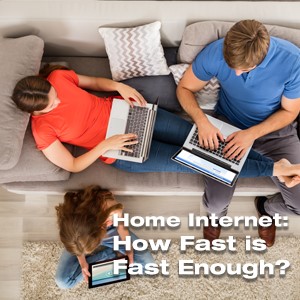 Internet service providers make a lot of claims about blazing fast speeds. Of course, they want you to subscribe to their highest bandwidth service.
Internet service providers make a lot of claims about blazing fast speeds. Of course, they want you to subscribe to their highest bandwidth service.
But, you may not need as much bandwidth as you think. How much you need ultimately depends on how you use your connection.
Ask yourself these three questions:
1. How many connected devices do you have in your home?
Bandwidth shared among all devices in your household may cause congestion. Congestion will reduce the speed of your connection and can lead to skipping, buffering and long download times. Think of it as a traffic jam of sorts where everybody is forced to slow down or even stop completely.
2. Do you use the internet just for basic web surfing, emailing and social media?
For one person, 5 Mbps or less should be adequate. A family of four may need up to 10 Mbps.
3. Do you frequently stream video, play online games, download files or share files among several connected devices?
Video streaming eats up the most bandwidth. Households running simultaneous streams will need more capacity. In this case, somewhere in the range of 10–25 Mbps is recommended.
Of course, the more data-intensive activities you undertake, and the more devices you have on the same connection, the more bandwidth you’ll need – perhaps as much as 50 Mbps.
Before you sign on the dotted line
Before you pay your provider for a 50 Mbps plan, there are some things to consider.
To compensate for the fact that they oversubscribe their networks, cable providers keep adding bandwidth to their plans – sometimes as much as 100-200Mb more. Unfortunately, as the number of customers using the same service increases, the actual bandwidth available for each individual customer decreases.
An internet connection is much like a highway. At 2 a.m. there is not much to get in your way. During rush hour however, it’s a different story. The number of drivers increases, but the size of the highway does not. As more drivers use the same road, everyone is forced to slow down.
At peak periods of use, your typical internet service will be congested – just like a highway at 5 p.m. That means that your 20 Mbps internet connection may only allow you to go up to 5 Mbps or even less. If you pay for 20 Mbps, but only get 5 Mbps at peak, you’re being overcharged. Don’t overpay. Avoid purchasing excess capacity that you do not need and that won’t do much to improve your connection.
The best value in internet service
Future Link IT is a different kind of provider. We offer affordable broadband internet service for residential users that provides fast response times and consistent speed on both uploads and downloads.
How do we do it? It’s simple – we don’t oversubscribe. Our network is designed for peak time usage – not average usage. Our customers report better results than they had with the plan offered by their cable provider.
Most importantly, with our plans, you get the connection speed that you pay for.
Call us today to find out more about our residential internet service.

